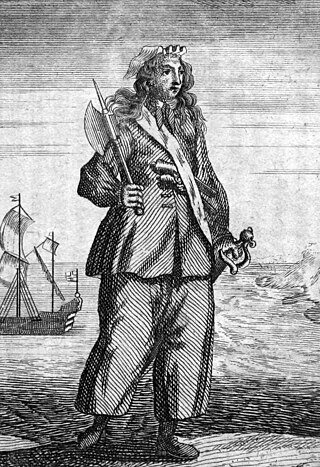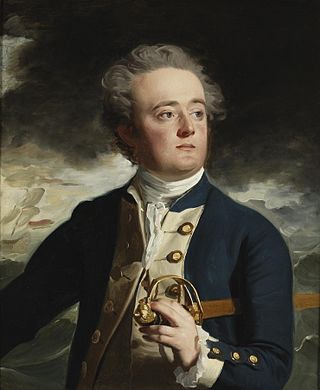
Jolly Roger is the traditional English name for the ensign flown to identify a pirate ship preceding or during an attack, during the early 18th century. The vast majority of such flags flew the motif of a human skull, or “Death's Head”, often accompanied by other elements, on a black field, sometimes called the “Death's Head flag” or just the “black flag”.

HMS Bellerophon, known to sailors as the "Billy Ruffian", was a ship of the line of the Royal Navy. A third-rate of 74 guns, she was launched in 1786. Bellerophon served during the French Revolutionary and Napoleonic Wars, mostly on blockades or convoy escort duties. She fought in three fleet actions: the Glorious First of June (1794), the Battle of the Nile (1798) and the Battle of Trafalgar (1805). While the ship was on blockade duty in 1815, Napoleon boarded Bellerophon so he could surrender to the ship's captain, ending 22 years of almost continuous war between Britain and France.

Mary Read, was an English pirate. She and Anne Bonny were among the few female pirates during the "Golden Age of Piracy".

Libertatia was a purported pirate colony founded in the late 17th century in Madagascar under the leadership of Captain James Misson. The main source for Libertatia is Volume 2 of A General History of the Pyrates, a 1724 book which describes Captain Misson and Libertatia. Little to no corroborating evidence for Libertatia beyond this account has been found, however. Whether Libertatia was real but somehow "lost" to history, a pirate legend that the author recorded based on interviews with sailors, or a concocted work of utopian fiction by the author from the start is contested.
Captain Charles Johnson was the British author of the 1724 book A General History of the Robberies and Murders of the most notorious Pyrates, whose identity remains a mystery. No record exists of a captain by this name, and "Captain Charles Johnson" is generally considered a pen name for one of London's writer-publishers. Some scholars have suggested that the author was actually Daniel Defoe, but this is disputed.

HMS Elephant was a 74-gun third-rate ship of the line of the Royal Navy. She was built by George Parsons in Bursledon, Hampshire, and launched on 24 August 1786.
William Brown was a Black woman who joined the Royal Navy in the early nineteenth century. It is undisputed that she was a sailor of HMS Queen Charlotte, but historians have reached varying conclusions about her service record.
Captain William Pryce Cumby was an officer in the Royal Navy whose excellent service during the French Revolutionary and Napoleonic Wars was highlighted when he was thrust into the limelight following his service at the Battle of Trafalgar. During the battle the French almost took his vessel, the ship of the line Bellerophon. Despite mounting casualties, heavy bombardment and the death of John Cooke, the captain of Bellerophon, the then Lieutenant Cumby ably took command, leading a charge that cleared his decks of boarders. He then captured the enemy ship from which the attack had come. He later served in the Caribbean and on convoy duties in the Atlantic. At the time of his death, he was Superintendent of Pembroke Dockyard.

Admiral Sir Henry D'Esterre Darby, was an officer in the Royal Navy. He was the third son of Jonathan and Susannah Darby of Leap Castle, in King's County, Ireland. He was the nephew of Vice Admiral George Darby. Darby first went to sea when he was thirteen but it was another fourteen years before he made lieutenant, aboard his uncle's ship HMS Britannia. In 1781, he was given command of the 8-gun Infernal but was captured after an inconclusive action at the Battle of Porto Praya and remained a prisoner for the rest of the war.

The Bibliotheca Classica, or Classical Dictionary containing a full Account of all the Proper Names mentioned in Ancient Authors, is the best-known work of John Lemprière, an English classical scholar. Edited by various later scholars, the dictionary long remained a readable if not absolutely trustworthy reference book in mythology and classical history. Lemprière wished "to give the most accurate and satisfactory account of all the proper names which occur in reading the Classics, and by a judicious collection of anecdotes and historical facts to draw a picture of ancient times, not less instructive than entertaining."

HMS Northumberland was a 74-gun third-rate ship of the line of the Royal Navy, built at the yards of Barnard, Deptford and launched on 2 February 1798. She carried Napoleon to his final exile on St Helena.

Rear-Admiral Sir Frederick Lewis Maitland was an officer in the Royal Navy during the French Revolutionary and Napoleonic Wars. He rose to the rank of rear admiral and held a number of commands. The most famous event of his career occurred when Napoleon Bonaparte surrendered to him aboard HMS Bellerophon, marking the final end of the Napoleonic Wars.
Pirates of the Golden Age of Piracy were organized criminals. As well as having crew members assigned certain duties, pirates found a way to reduce conflict among themselves and maximize profits. They used a democratic system, spelled out by written "articles of agreement", to limit the captain's power and to keep order on board the ship.

Pirates of the Caribbean: The Price of Freedom is a 2011 adventure novel written by Ann C. Crispin. The book details the adventures of Captain Jack Sparrow as a young man after the events of Pirates of the Caribbean: Jack Sparrow and before the events of Pirates of the Caribbean: Legends of the Brethren Court. This is the final novel written by Crispin, who died in September 2013.
Sir Samuel Warren KCB, KCH was an officer of the Royal Navy who served during the American War of Independence, and the French Revolutionary and Napoleonic Wars.
Edward Hawker was an officer of the Royal Navy who served during the French Revolutionary and Napoleonic Wars.

John Loring was an officer in the Royal Navy who served during the American War of Independence and the French Revolutionary and Napoleonic Wars.
William Moody was a London-born pirate active in the Caribbean and off the coast of Africa. He is best known for his association with Olivier Levasseur and Thomas Cocklyn, crewmembers who succeeded him as captains in their own right.
Richard Frowd was a pirate active in the Caribbean. He is best known for sailing with William Moody. He was one of a number of pirates to have both white and black sailors in his crew.

Jonathan Barnet was an English privateer in the Caribbean, best known for capturing pirates Calico Jack, Anne Bonny, and Mary Read. The Assembly of the Colony of Jamaica gave him a financial reward, and a large estate in the parish of St James worked by African slaves.











